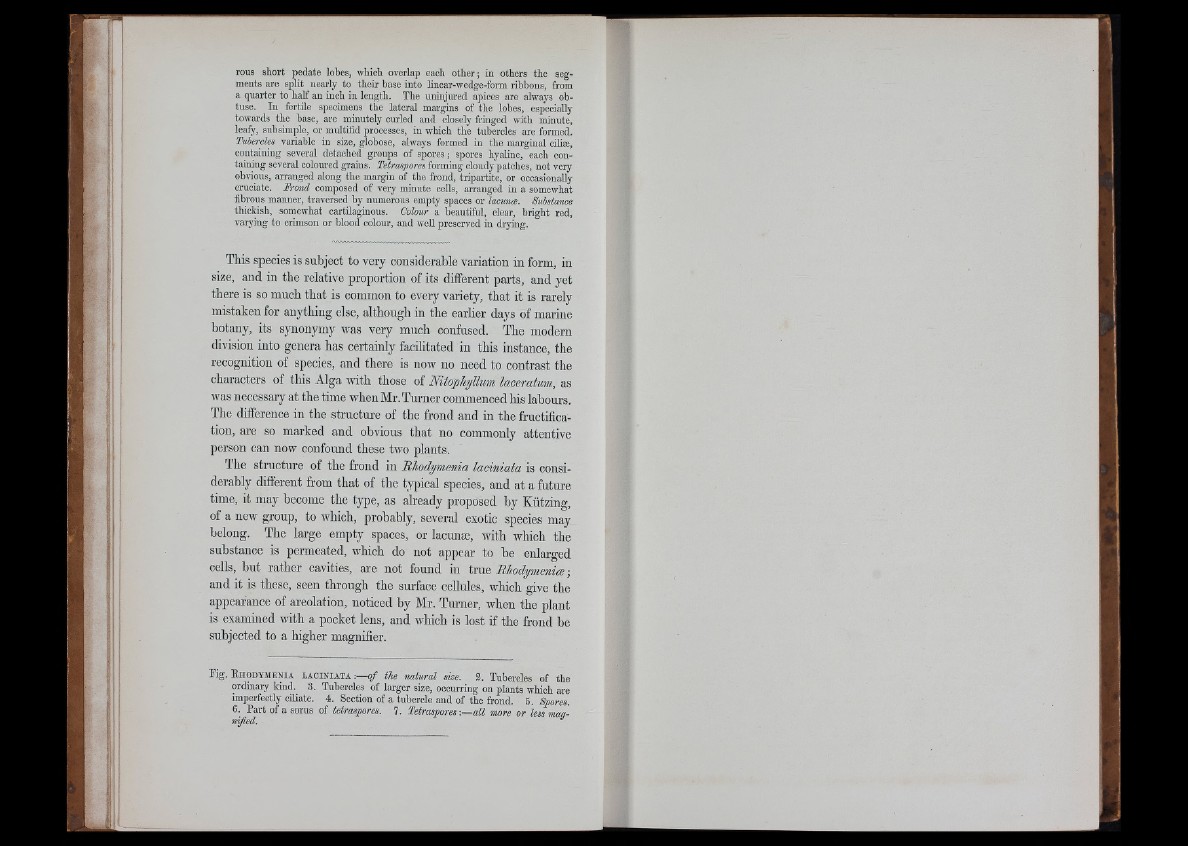
rous short pedate lobes, which overlap each other; in others the segments
are split nearly to their base into linear-wedge-form ribbons, from
a quarter to half an inch in length. The uninjured apices are always obtuse.
In fertile specimens the lateral margins of the lobes, especially
towards the base, are minutely curled and closely fringed with minute,
leafy, siibsimple, or midtifid processes, in which the tubercles are formed.
Tubercles variable in size, globose, always formed iu the marginal cilise,
containing several detached groups of spores; spores hyaline, each containing
several coloured grains. Tetraspores forming cloudy patches, not very
obvious, arranged along the margin of the frond, tripartite, or occasionally
cruciate. Frond composed of very minute cells, arranged in a somewhat
fibrous manner, traversed by numerous empty spaces or lacuna. Substance
thickish, somewhat cartilaginous. Colour a beautiful, clear, bright red,
varying to crimson or blood colour, and well preserved in drying.
This species is subject to very considerable variation in form, in
size, and in the relative proportion of its different parts, and yet
there is so much that is common to every variety, that it is rarely
mistaken for anything else, although in the earlier days of marine
botany, its synonymy was very much confused. The modern
division into genera has certainly facilitated in this instance, the
recognition of species, and there is now no need to contrast the
characters of this Alga with those of Nitophyllum laceratum, as
was necessary at the time when Mr. Turner commenced his labours.
The difference in the structure of the frond and in the fructification,
are so marked and obvious that no commonly attentive
person can now confound these two plants.
The structure of the frond in Hhodymenia laciniata is considerably
different from that of the typical species, and at a future
time, it may become the type, as already proposed by Kiitzing,
of a new group, to which, probably, several exotic species may
belong. The large empty spaces, or lacunae, with which the
substance is permeated, which do not appear to be enlarged
cells, but rather cavities, are not found in true HhodymenicB \
and it is these, seen through the surface cellules, which give the
appearance of areolation, noticed by Mr. Turner, when the plant
is examined with a pocket lens, and which is lost if the frond be
subjected to a higher magnifier.
Fig. R hodymenia laciniata -.— o f tie natural size. 3. Tubercles of the
ordinary kind. 3. Tubercles of larger size, occurring on plants which are
imperfectly ciUate. 4. Section of a tubercle and of the frond. 6. Spores.
6. Part of a sorus of tetraspores. 7. Tetraspores-.— all more or less maa